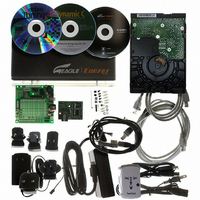101-1218 Rabbit Semiconductor, 101-1218 Datasheet - Page 40

101-1218
Manufacturer Part Number
101-1218
Description
KIT APPLCTN RABBITCORE RCM4010
Manufacturer
Rabbit Semiconductor
Series
RabbitCore®r
Datasheet
1.20-101-1094.pdf
(130 pages)
Specifications of 101-1218
Main Purpose
*
Embedded
*
Utilized Ic / Part
RCM4010
Primary Attributes
*
Secondary Attributes
*
Processor To Be Evaluated
Rabbit 4000
Interface Type
Ethernet
Operating Supply Voltage
12 V
Lead Free Status / RoHS Status
Not applicable / Not applicable
Other names
316-1156
- Current page: 40 of 130
- Download datasheet (809Kb)
4.2 Serial Communication
The RCM4000 module does not have any serial transceivers directly on the board. How-
ever, a serial interface may be incorporated on the board the RCM4000 is mounted on. For
example, the Prototyping Board has an RS-232 transceiver chip.
4.2.1 Serial Ports
There are five serial ports designated as Serial Ports A, B, C, D, and F. All five serial ports
can operate in an asynchronous mode up to the baud rate of the system clock divided by 8.
An asynchronous port can handle 7 or 8 data bits. A 9th bit address scheme, where an
additional bit is sent to mark the first byte of a message, is also supported.
Serial Port A is normally used as a programming port, but may be used either as an asyn-
chronous or as a clocked serial port once application development has been completed and
the RCM4000 is operating in the Run Mode.
Serial Port B is shared by the RCM4000 module’s A/D converter, and is set up as a
clocked serial port. Since this serial port is set up for synchronous serial communication
on the RCM4000 model, you will lose the A/D converter’s functionality if you try to use
the serial port in the asynchronous mode. Serial Port B is available without any restrictions
on the RCM4010.
Serial Ports C and D can also be operated in the clocked serial mode. In this mode, a clock
line synchronously clocks the data in or out. Either of the two communicating devices can
supply the clock.
Serial Port F, which is available as a matter of course on the RCM4010 and can be used
instead of Serial Port C on Parallel Port C pins 2 and 3, can also be configured as an
SDLC/HDLC serial port. The IrDA protocol is also supported in SDLC format by this
serial port. Serial Port F must be configured before it can be used. The sample program
in the Dynamic C
folder
IOCONFIG_SWITCHECHO.C
SAMPLES\RCM4000\SERIAL
shows how to configure Serial Port F.
34
RabbitCore RCM4000
Related parts for 101-1218
Image
Part Number
Description
Manufacturer
Datasheet
Request
R

Part Number:
Description:
COMPUTER SNGLBD BL2120 FRCTNLOCK
Manufacturer:
Rabbit Semiconductor
Datasheet:

Part Number:
Description:
KIT MESH NETWORK ADD-ON RCM4510W
Manufacturer:
Rabbit Semiconductor
Datasheet:

Part Number:
Description:
KIT DEV FOR BL2500 COYOTE
Manufacturer:
Rabbit Semiconductor
Datasheet:

Part Number:
Description:
KIT APPLICATION SIMPLE SENSOR
Manufacturer:
Rabbit Semiconductor
Datasheet:

Part Number:
Description:
KIT ETHERNET INT'L RCM3720
Manufacturer:
Rabbit Semiconductor
Datasheet:

Part Number:
Description:
KIT SERIAL-ETHERNET APPLICATION
Manufacturer:
Rabbit Semiconductor

Part Number:
Description:
KIT APPLICATION MULTI-PORT S2E
Manufacturer:
Rabbit Semiconductor

Part Number:
Description:
KIT WEB SECURE EMBEDDED RCM3700
Manufacturer:
Rabbit Semiconductor
Datasheet:

Part Number:
Description:
MODULE RABBITCORE RCM3720
Manufacturer:
Rabbit Semiconductor
Datasheet:

Part Number:
Description:
MODULE RABBITCORE RCM3220
Manufacturer:
Rabbit Semiconductor
Datasheet:

Part Number:
Description:
MODULE RABBITCORE RCM3210
Manufacturer:
Rabbit Semiconductor
Datasheet:

Part Number:
Description:
COMPUTER SGL-BOARD OP6600 W/SRAM
Manufacturer:
Rabbit Semiconductor
Datasheet:

Part Number:
Description:
COMPUTER SGL-BD BL2000 SRAM/FLSH
Manufacturer:
Rabbit Semiconductor










